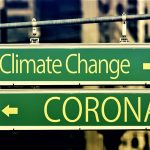
Anthropogenic climate change results from the concentration of greenhouse gases in the atmosphere. This phenomenon is responsible for a relentless upward trend in global temperature. The hottest years ever recorded over 140 years of modern weather record-keeping have all occurred since 1998, and 9 of the 10 have occurred since 2005. The July 2020 global temperature was the highest ever recorded in the Northern Hemisphere for July, and the second-warmest July worldwide.
Although discussions of climate change frequently are centered on predictions of a calamitous future, climate change has already increased the incidence and exposure risk for many infectious diseases. A greater frequency of climate-change associated extreme weather events, such as heat waves, drought, and floods, have changed patterns of human migration and created an increased human-to-human transmission risk for novel diseases.
Climate change has also resulted in the expansion of the range of numerous pathogenic microorganisms, vectors, reservoirs, and hosts beyond their traditional geographic boundaries. Higher water temperatures caused by absorption of heat from greenhouse gas emissions and changes in salinity due to altered precipitation patterns and sea level rise have been implicated in the expansion of the population of Vibrio, a marine bacterium which causes diarrheal disease, wound infections, septicemia, and cholera.
Socioeconomic improvements and public health efforts aimed at mosquito eradication have succeeded in reducing the burden of malaria, but concerns remain that a warming climate will increase mosquito populations at higher latitudes and altitudes and lead to a greater incidence of mosquito borne viruses. One model predicts that in a worst-case scenario, climate change will cause 1 billion people to face their first exposure to viruses spread by mosquitos of the Aedes genus, including dengue, chikungunya, and Zika by the end of the 21st century.
Ixodes scapularis, the tick that spreads Lyme disease and other tick-borne illnesses, was previously found primarily in the Northeastern United States. Currently, multiple species of ticks are now present in all 50 states and in parts of Canada, due in part to the weather-mediated expansion of the range of reservoirs and hosts such as the white-footed mouse and the white-tail deer. Additionally, a warming climate increases the potential for human-tick encounters during winter months. Cases of tick-borne diseases reported via the Notifiable Disease Surveillance System (NNDSS) at the US Centers for Disease Control and Prevention (CDC) doubled from 22,527 cases in 2004 to 48,610 cases in 2016.10 And while direct links to climate change have not been established for the current coronavirus disease 2019 (COVID-19) pandemic, higher fatality rates and a greater prevalence of COVID-19 have been observed in areas with high air pollution, which has been identified as both a cause and consequence of climate change.
Clinicians who treat infectious diseases should be aware of the changes in clinical presentation that can result from climate change, noted Rachel Harold, MD, a recent graduate of the infectious disease fellowship at George Washington University, in an interview with Infectious Disease Advisor. “We tend to rely on patterns when we see patients. We think that if it’s February, this is not likely to be West Nile virus, and this is not a region where it could be here,” she said. “We need to loosen some of that. We need to keep an open mind in what we expect to see and recognize that temporal and geographic disease patterns are going to be changing over time.”
Mona Safarty, MD, MPH, FAAFP, Executive Director of the Medical Society Consortium on Climate and Health and Director of the Program on Climate and Health within the Center for Climate Change Communication at George Mason University, told Infectious Disease Advisor that individual clinicians are well-positioned to help their patients to avoid some of the health risks associated with climate change. “Some of the dangers that can be avoided with useful information include worsening air pollution, more severe allergy seasons, extreme heat, mosquito or tickborne diseases, and contaminated water and food,” Dr Safarty said.
“Clinicians can also use their trusted health voices to let policymakers know about how public health policies can protect us from the health dangers and how clean energy solutions can slow the damage to the climate,” said Dr Safarty.
“There are so many things you can do in response to climate change to help prevent adverse impacts on a patient and their communities. But the responsibility is also there to take action to mitigate the climate crisis,” Dr Harold added. “Climate change has already made an effect on infectious disease epidemiology, and the impacts will continue to increase — but by no means is it over. There’s certainly plenty of opportunity for us to move towards a more low carbon society and change our practices and our economy to change the trajectory and reduce the impact of climate change.”
Source: Infectious Disease Advisor

















